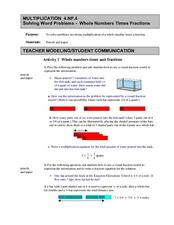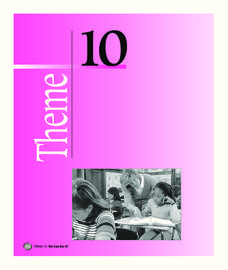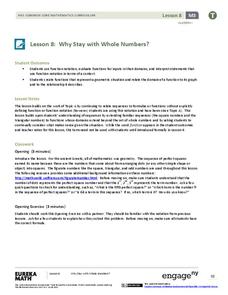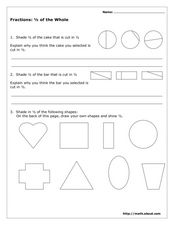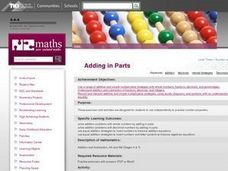Fraction Bars
Solving Word Problems - Whole Numbers Times Fractions
An impressive lesson where pupils visualize models and solve problems involving multiplying a whole number times a fraction. Fraction bars are used to help learners truly understand what's happening during this mathematical process. The...
Fraction Bars
Quotients of Whole Numbers that Equal Fractions
A complete lesson on dividing whole numbers by other whole numbers and getting a fraction result. Groups of learners use fractions bars, and strips of paper that are cut to specific lengths. The hands-on activities in the lesson are...
K12 Reader
Fractions as Parts of a Whole
Whether used to introduce learners to fractions or as a comprehension assessment, this two-part, cross-curricular worksheet will give readers a chance to test their understanding of fractions.
Digital Forsyth
Parts of a Whole
High school artists create a collaborative piece based on a historical image. Each member of the class is given two days to draw one part of the whole image, when the two days are up; they put their pieces together and discuss the...
EngageNY
Interpreting Division of a Whole Number by a Fraction—Visual Models
Connect division with multiplication through the use of models. Groups solve problems involving the division of a whole number by a fraction using models. The groups share their methods along with the corresponding division and...
Illustrative Mathematics
How Many Servings of Oatmeal?
Here is another way to illustrate division of a whole number by a unit fraction. In this case, the problem is asking if there are so many servings per cup, how many servings are in a package of multiple cups. Learners are to model their...
Houghton Mifflin Harcourt
We Can Do It!: English Language Development Lessons (Theme 10)
English language development lessons are brought to you in poems, picture cards, and grand discussions in a We Can Do It! themed unit. Topics of discussion include daily challenges, parts of a whole, words that describe what we...
Curated OER
Fractions
Represent fractions visually using shape models. Scholars color in two sets of shapes to represent specific fractions: 2/3 and 3/4. The shapes are segmented into equivalent fractions for most of these, so scholars need to understand this...
EngageNY
Why Stay with Whole Numbers?
Domain can be a tricky topic, especially when you relate it to context, but here is a lesson that provides concrete examples of discrete situations and those that are continuous. It also addresses where the input values should begin and...
Curated OER
Place Value for Whole Numbers
Work with small and large numbers alike with a place-value activity. After writing the value of selected numbers, fourth graders write what happens to each number if they change certain parts of it.
Illustrative Mathematics
Cooking with the Whole Cup
Whoops! Travis accidentally put too much butter into the recipe. Your bakers must find out how to alter the recipe to accommodate different changes by using unit rates and ratios . The activity has multiple parts and calculations with...
Curated OER
Treble Clef Quiz Part I: The Basics
This three-part quiz tests learners knowledge of the treble clef by asking them to name the parts of the treble clef, to write the letter names under the notes represented, and to write the note names on the correct line or space.
Turabian Teacher Collaborative
Parts of Argument II: Article Critique
Break down the parts of argumentative writing with a critical thinking activity. High schoolers read an article of your (or their choice), and use a graphic organizer to delineate the ways the author structures his or her arguments.
EngageNY
Construct an Equilateral Triangle (part 1)
Drawing circles isn't the only thing compasses are good for. In this first installment of a 36-part series, high schoolers learn how to draw equilateral triangles by investigating real-world situations, such as finding the location of a...
Teach Engineering
Nanotechnology as a Whole
It's a small (nanotechnology) world after all! The first segment of a six-part series gives an overview of nanotechnology, its principles and applications, and shares some of the engineering applications of nanotechnology. A...
Missouri Department of Elementary
Conflict Mediation – Part 1: Getting Ready
Two scholars walk into a room arguing, what is happening? Peers observe the two actors in preparation for a whole-class discussion about conflict. Learners establish a conflict, name the three approaches—passive, aggressive, and...
Missouri Department of Elementary
Safe and Healthy Life Choices (Part I)
As high schoolers seek to grow more and more independent, they must constantly make choices. Some options are healthy and some not so much. To begin the discussion, class members are asked to identify five safe and healthy (or...
EngageNY
Close Read, Part 1: “Hugo, the Lord’s Nephew”
Fourth time is a charm. Learners complete multiple reads of Hugo, the Lord’s Nephew. On the fourth read, they make notes about each page on sticky notes. They then complete a think-pair-share activity with a partner to determine the...
Alberta Learning
Proper Fractions: Activity Sheet
Practice identifying fractions with a worksheet that asks scholars to explore drawings and pinpoint parts of a whole. Class members asses figures and objects to identify the numerator, denominator, and write them in fraction form.
Curated OER
Understanding Fractions
Students explore the parts of an orange to develop an understanding of the addition and subtraction of fractions. The concept of representing parts of a whole by dividing an object into smaller pieces is experienced in this hands-on...
Curated OER
Fractions lesson 1
Students are given an overview of fractions using fractions manipulatives. Students comprehend what numerators and denominators are. They demonstrate a clear comprehension that the size of a fraction depends on the number of parts the...
Curated OER
Fractions: One Half of the Whole
In this recognizing halves as fractional parts of wholes worksheet, learners identify and shade the figures that are divided in half. Students color and explain 12 answers.
Curated OER
Adding in Parts
Third graders are able to split whole numbers into parts. They make numbers up to a tidy number. Students add and subtract tenths to make a decimals number into a whole number. They are able to add whole numbers up to three digits.
Curated OER
Wholes and Parts
For this fraction parts worksheet, students solve the word problems by finding the parts and wholes for each problem and the fraction that matches the parts and wholes.
Other popular searches
- Fractions Parts and Wholes
- Math Parts and Wholes
- Wholes and Parts
- Fractions Parts of Wholes
- Parts and Wholes Science
